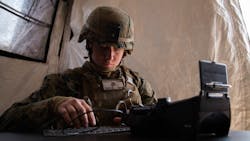Raytheon joins DARPA project to speed application software by improving network interface cards (NICs)
ARLINGTON, Va. – Computer scientists at Raytheon Technologies Corp. to explore ways of speeding-up complex application software like distributed training of machine learning classifiers.
Officials of the U.S. Defense Advanced Research Projects Agency (DARPA) in Arlington, Va. announced a $12 million contract to the Raytheon Intelligence & Space segment in Cambridge, Mass. (formerly Raytheon BBN Technologies Corp.) last week for a research project in the first phase of the DARPA Fast Network Interface Cards (FastNICs) program.
FastNICs seeks to find ways of improving network stack performance in military embedded computing systems to realize 100x or more throughput gains, and to accelerate distributed applications, such as training of deep neural networks.
Raytheon BBN joins Perspecta Labs Inc. in Basking Ridge, N.J., on the FastNICs project. Perspecta won a $29.7 million contract for the FastNICs project in early May.
Related: SFF embedded computing for C4ISR
Current network subsystems represent a bottleneck between multiprocessor servers and the network links that interconnect them, DARPA officials explain. This bottleneck has worsened dramatically over time because of the increasing use of parallelism in processor design aimed at increasing central processing unit (CPU) performance.
Although this design strategy can be effective for CPUs, it has limited overall computer performance because network link performance has not matched processor gains; there is a performance imbalance between network links and other computer system components, researchers explain.
The separate evolutions of network and server technology have made network interface cards (NICs), which bridge the network/server boundary, an afterthought.
This can be a problem because network interface hardware imposes the upper bound for server throughput, as it limits a processor’s data-ingest capability. Limitations in server memory technologies, software that exhibits excessive memory copying, and poor application design also can throttle computer throughput.
Network interface cards (NICs) typically operate at far slower rates than today’s multicore multiprocessors and graphic processing unit (GPU)-equipped servers, which highlights the need for breakthrough approaches in increasing NIC speeds.
Related: 10-gigabit Ethernet-over-copper network interface card
The DARPA FastNICs project seeks to speed-up applications such as the distributed training of machine learning classifiers by 100x by developing new network subsystem designs.
The program focuses on overcoming the gross mismatches in computing and network subsystem performance -- especially computer network interface performance, which lags computer subsystems like RAM and CPU by three to four orders of magnitude, DARPA researchers say.
FastNICs is a four-year program organized into three phases. The first two-year phase will develop a small-scale proof-of-concept that integrates hardware, system software, and application software, with an goal of producing a 5x application speedup over the current state of the art.
The second one-year phase will focus on scaling-up proof-of-concept technology. The one-year third phase aims at a 4x application speedup over the second phase.
Related: NDDS software tool helps engineers integrate shipboard network
The project also has three technical areas: network subsystem hardware and software; applications; and independent test and evaluation.
Network subsystem hardware and software focuses on improving raw server data path speed by demonstrating 10-terabit-per-second network interface hardware using existing or road-mapped hardware interfaces.
Applications seeks new software that fast server data paths enable by implementing at least one application that demonstrates a 100x speedup when executed on the hardware/software stack developed in the project's first phase. Independent test and evaluation seeks to provide objective and convincing evidence for the impact of FastNICs.
On this contract Raytheon BBN will do the work in Cambridge, Mass., and in Seattle, and should be finished by June 2024. For more information contact Raytheon Intelligence & Space online at www.raytheonintelligenceandspace.com, or DARPA at www.darpa.mil.
About the Author
John Keller
Editor-in-Chief
John Keller is the Editor-in-Chief, Military & Aerospace Electronics Magazine--provides extensive coverage and analysis of enabling electronics and optoelectronic technologies in military, space and commercial aviation applications. John has been a member of the Military & Aerospace Electronics staff since 1989 and chief editor since 1995.
